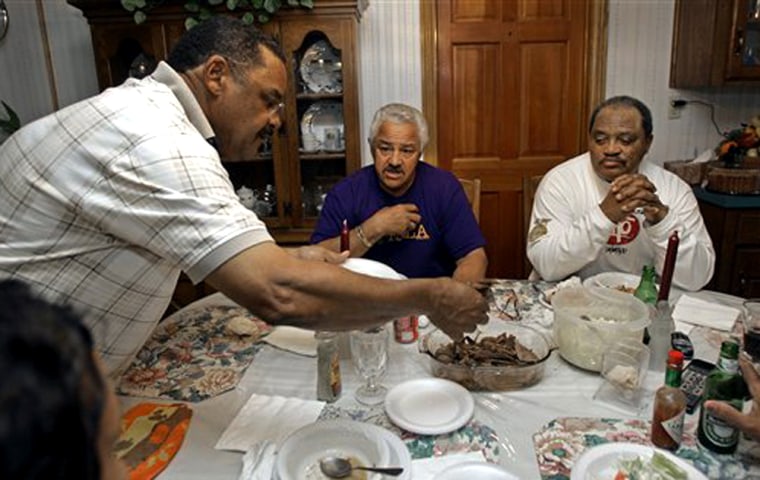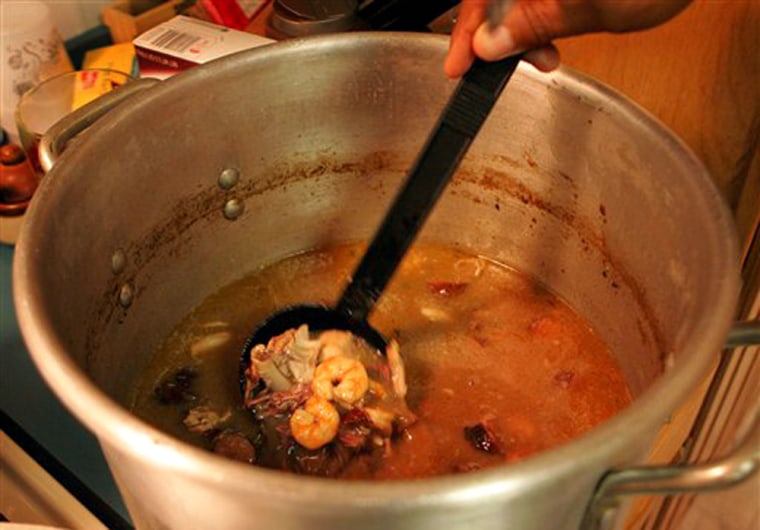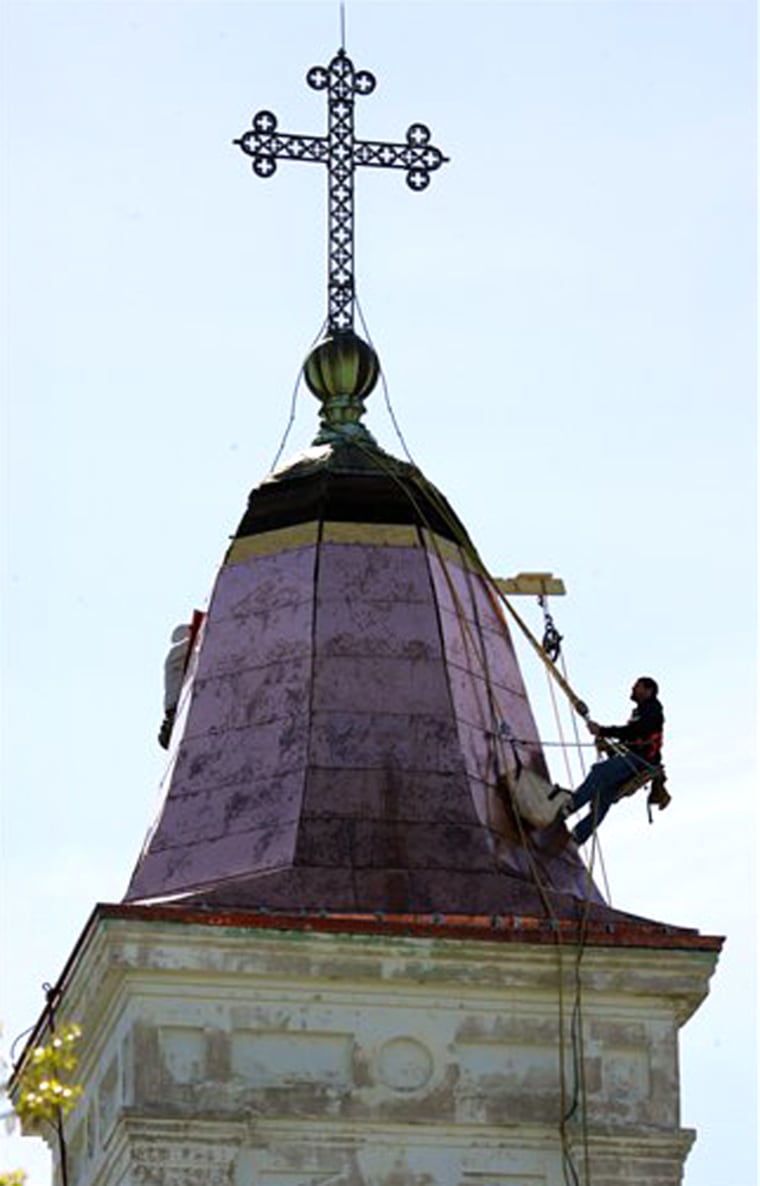Ray Heisser misses the surprise visits. The doorbell on Camberley Drive would chime and there’d be an old friend on Heisser’s porch mopping the humidity off his forehead, stopping by for no good reason. “What y’all gettin’ into? Come on, take a drive with me.”
They had teamed up for grade-school baseball games, cradled one another’s newborns and raised beer bottles to celebrate retirements. Before Katrina scattered them to Las Vegas and Houston, they lived half-mile from one another in a quiet, mostly black neighborhood dotted with palm trees and ponds.
“We’ve been knowing each other since we were this big,” says the 66-year-old Heisser, lowering a weathered, big-knuckled hand down to his knee. “What I miss most is my way of life. The unity.”
Austin J. Badon Sr. nods: “It’s a friendship, but it’s also a family.”
Most people they know want to rebuild, eventually. But no one can quite imagine the day when their houses will be livable again and now the glue of their lives is gone — their neighbors, local businesses, social clubs. Just about every black institution in town is struggling or has disappeared.
What is any school or church or company without its people?
“The culture is all about the people,” Heisser says. “That’s a big part of New Orleans.”
Even if everyone came back tomorrow, the scars would last a long time.
But let’s face it — not everyone’s coming back. Barely 200,000 are now living in the city. Before Katrina, there were 465,000 residents, seven in 10 of them black. Experts including the Rand Corp., a nonprofit think tank, agree it’ll stay smaller than it was for years. It will almost surely be less black.
A Gallup poll telephoned people who were back as of February and found that 52 percent were white and 37 percent were black. Many more black people than white people said they were struggling to get back to work, jump-start their social lives and find someone to rebuild their homes.
Losing St. Augustine
No surprise for the people who once worshipped at St. Augustine, a 19th-century Roman Catholic church whose gleaming, newly repaired copper bell tower looms over wooden cottages in the Treme neighborhood. It was one of the nation’s oldest black Catholic parishes, where jazz saxophones spiced up Mass and the parish priest wore robes embellished with African Kente cloth.
Even though the building didn’t flood in Katrina, the archdiocese closed the parish and removed the priest in mid-March, saying membership was too low. The protests were long and loud. Some parish supporters barricaded themselves in the rectory.

“This community has drawn the line here,” said Jacques Morial, whose family has been part of the church for generations. For him, losing St. Augustine means losing a hub of friendships — and a cornerstone of black New Orleans.
“Black people of modest income define the social fabric and culture here,” he said, standing near St. Augustine’s Tomb of the Unknown Slave, a 15-foot iron cross made of fist-sized chain links dredged from the bottom of the Mississippi River.
If that changes, he said, the city will becomes little more than a tourist attraction. “It becomes a Disneyland, approaching contrivance,” he said. “It was happening before, and it’s accelerating now.”
You can see it everywhere.
Stuffed shrimp no more
A mile from St. Augustine, Dooky Chase’s restaurant in Esplanade is still closed after being flooded and looted. The 65-year-old restaurant where the gumbo was cooked with fresh file and the paneed meat — veal to non-New Orleanians — was perfectly tender.
“Dooky Chase’s stuffed shrimp — I don’t know what it’s stuffed with, maybe some kind of meat, but it’s shrimp and it’s stuffed and it’s big and it’s very good,” said Keith Weldon Medley, once a regular customer. “We met there every month.”
“We” was his social club, The Bunch, an 89-year-old black group with about 50 members. They’ve barely caught up with each other since Katrina and their annual Mardi Gras dance was canceled for the first time in decades.
“There was not one black ball this Mardi Gras season. Usually there are 20 or 30,” said Medley, a lifelong city resident and expert on black history. “A lot of traditions have a rip in them.”
People like Medley are the die-hards. He evacuated to Dallas but couldn’t stay away and soon moved back. But he and others now live in a place that barely feels like itself. “There’s a tremendous void,” he said.
Trailer Park Drive
The Badons feel it. They’ve been living in a FEMA trailer in their driveway on Winchester Park Drive since October. There are five other trailers on the street, all empty.
“Some on our street are returning but four houses are for sale and two others have been sold,” said Austin Badon, scanning the block. “The ones who are returning are like me: They’re in a waiting mode. We’ll wait for the end of the upcoming hurricane season until we start working on the house.”
His wife, Brenda Morgan-Badon, says she misses her regular breakfasts at the boarded-up International House of Pancakes and dawdling with friends over slot machines at Harrah’s Casino. She rushes home before nightfall these days, spooked by the emptiness of her own neighborhood where streetlights still don’t work.
“The streets are too dark out here and there’s nothing — NOTHING — open,” she said. “Not even a gas station.”
Absence of customers
In nearly all black areas, local businesses simply don’t have enough customers.
On St. Bernard Avenue in the Seventh Ward, there’s hardly anywhere to make groceries, as New Orleanians say. Poke your head through the shattered windows at the decades-old Circle Food Store and a moldy smell lurks. A deli counter and dry goods shelves are still in a jumble where the floodwater tossed them.
Across town, Downman Road was a bustling four-lane highway before the Industrial Canal flooded and nearby working class black neighborhoods drowned. Most traffic lights still don’t work and “For Sale or Rent” signs are everywhere, on businesses like Burger Orleans and the Downman Supermarket.
The only open business one recent afternoon was Visions Men’s Club, a squat, windowless building where the parking lot was crammed with dusty pickup trucks, toolboxes mounted in the cabs — from the look of it, construction workers taking a break from repairing houses.
There’s no shortage of work for them.
Houston ‘isn’t home’
Nearly eight in 10 people asked by Gallup said they want to rebuild their homes and stay in the city. People like Debra Matthews. She ran from North Johnson Road, where the wind blew out her windows and destroyed much of the roof on her wooden, shotgun house. But it didn’t flood, so she was back a few weeks ago looking for an apartment.
Her daughter had just installed a FEMA trailer on a dusty patch of grass littered with deflated tires and waterlogged toys.
“Once one in the family gets stability, they can pull the other ones back,” she said, buckling two grandchildren into their car seats. “Houston welcomed us, but it isn’t home.”
Families like Matthews’ make Sylvester Francis hopeful for black New Orleans. He runs the Backstreet Cultural Museum, a one-man, one-room establishment filled with Mardi Gras Indians costumes on display — a kaleidoscope of hot-pink feathers and canary yellow sequins. He said Katrina wasn’t the worst thing that’s hit black New Orleans.
“If the whip didn’t change us, ain’t nothing gon’ change us,” he said. “This history will never die. The people gon’ come back.”
Political whirlwind
But the neighborhoods are still patchy at best, and many blacks say the mayor’s race is a sure sign of how New Orleans is changing. Black mayors have run the city since 1978, and blacks’ domination of politics has been so airtight that serious white candidates have rarely bothered to run.
Until Katrina, that is. Now, Mayor C. Ray Nagin is facing 23 challengers. Most are white.
Nine in 10 white voters supported Nagin the first time around — compared to four in 10 black voters — but not anymore.
Some blame him for not doing more before and after Katrina.
Many whites were offended when he told blacks in January that New Orleans would be a “chocolate city” again. There’s a don’t-be-so-sure attitude among many, who sense that the black majority may have disintegrated: Some have dubbed Nagin “Mayor Wonka,” and boutique owners in the mostly white Uptown area are selling out of “Uptown White Chocolate” T-shirts.
‘Changing of the guard’ expected
“Politically, I’m sure we’ll have a changing of the guard,” said Maurice Mondell, a college friend of Heisser and Badon. They and several other buddies got together recently at a mutual friend’s house in Edgard, 40 miles west through green swamps and sugar cane fields from New Orleans.
“A large reason so many (candidates) are in the mayor’s race is because blacks aren’t here to vote,” Mondell said. To whites, he said, this was just “recapturing the land.”

The friends moaned about their city and pined for the old days while they piled plastic foam plates with creamy red beans and crawfish from a 10-gallon pot. “Everybody’s gone different ways,” said Brenda Morgan-Badon, her voice cracking as she stared hard into her glass of blush wine.
Every few minutes, someone asked, “Where’s Frankie?”
“California” Frankie, or Frank Garnett, the group’s jokester, had grown up with them but moved to Los Angeles in 1967. Still, he had been back three or four times a year until Katrina.
‘These are my roots’
At last Frankie arrived, slapping hugs on his friends’ backs as they ribbed him for being late.
So, what keeps pulling you back to New Orleans, Frankie? He dodged the question — changed the subject.
Finally, he folded his tall, baseball player’s frame into a wooden kitchen chair and challenged, “What, you just want me to cry?” The room hushed as he pushed his thumb and forefinger under his glasses, rubbing.
“We’ve been together all our lives.”
He leaned forward, his voice was gravely. “These are my roots.”
“I can’t believe it’s still this bad,” he said, shaking his head. “I went into my mother’s house and her ceiling was on the floor.
“I just don’t see how the old neighborhood is going to come back.”
